We’ve been fortunate to eat a lot of delicious tropical fruits on this trip. Some are well known and enjoyed in the States, some are available in the States but a bit harder to find, and some are only found locally. Here is a quick description of some of the familiar and exotic fruits we’ve been eating in order of what we think will be most to least familiar for our readers.
Mango
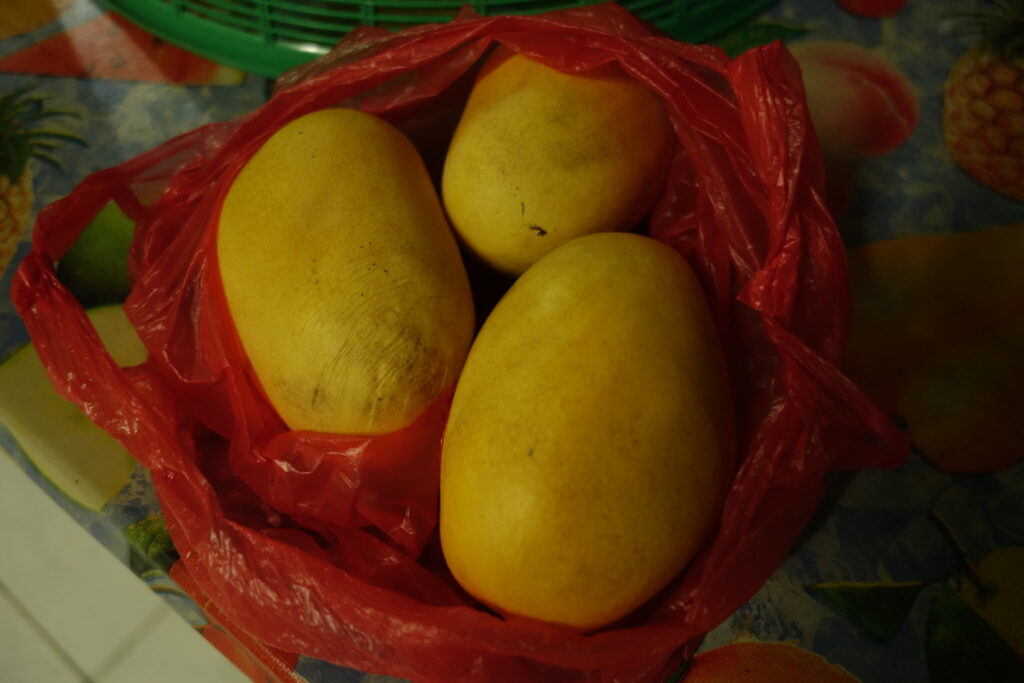
The Philippines unarguably have the best mangoes in the world. They are phenomenal both sliced and eaten raw, blended into smoothies, and dried. In fact, the cultivar grown there (Carabao) is certified the sweetest in the world by the Guinness Book of World Records. At prices ranging from $.70 to $1.50 the mango smoothies were cheap enough that we had them every day we ate at a restaurant that sold them.
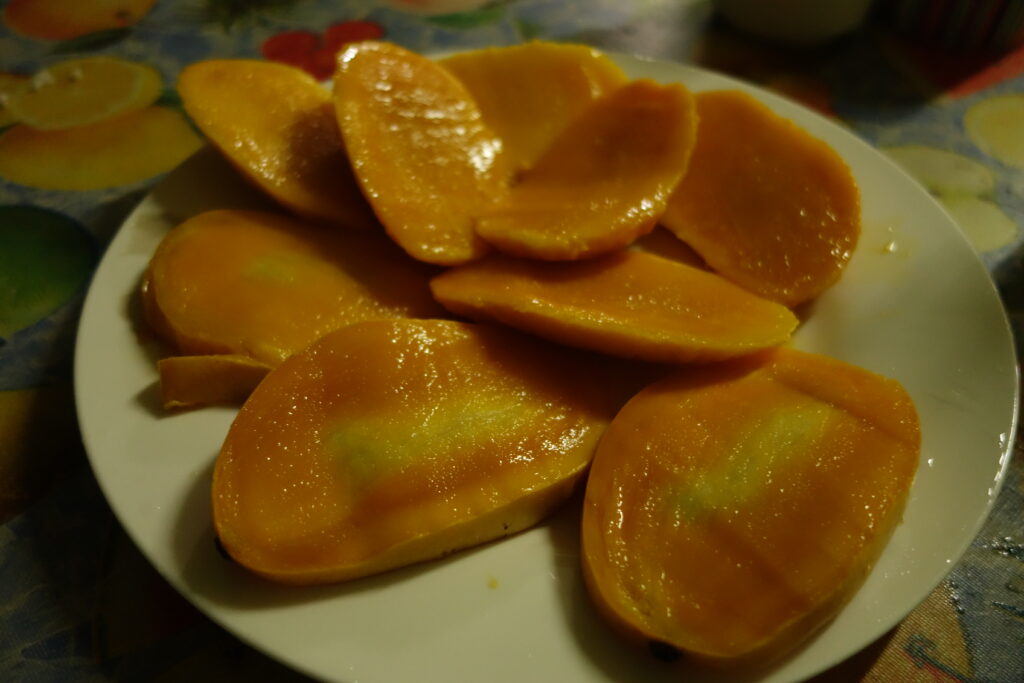
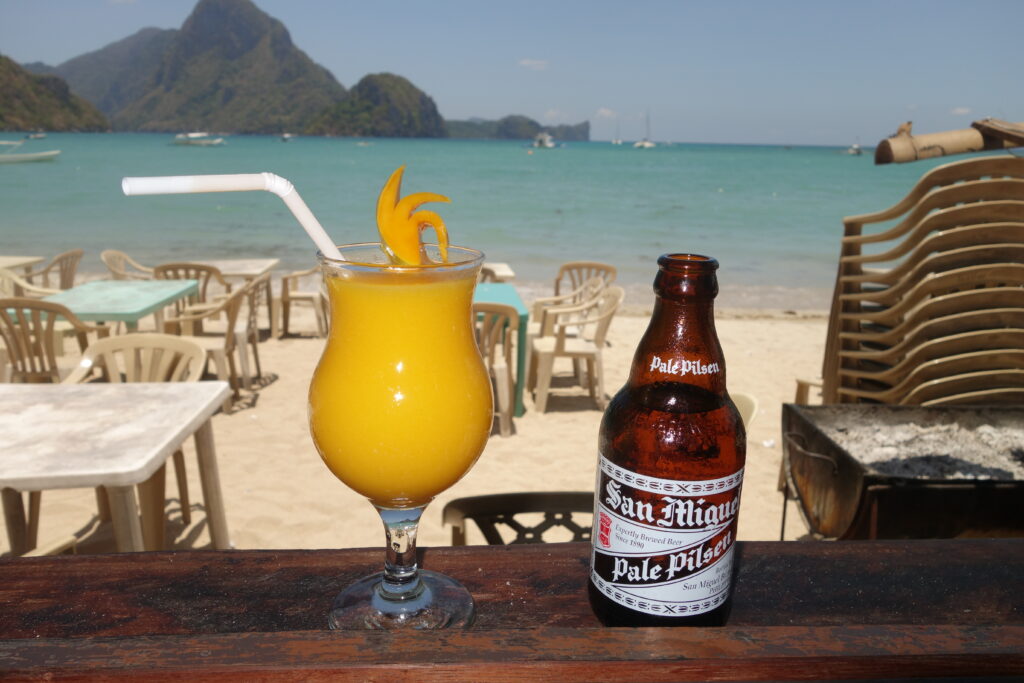
Pineapple
Everyone loves pineapple, right? I don’t have much to say about pineapple other than in virtually every language but English it is called “ananas”. This derives from the language of the Tupi peoples of Brazil where the fruit was called “nanas” which meant “excellent fruit”. Indeed. Pineapples are sold with the rind skillfully removed in a spiral pattern and ready to eat in both the Philippines and Vietnam.
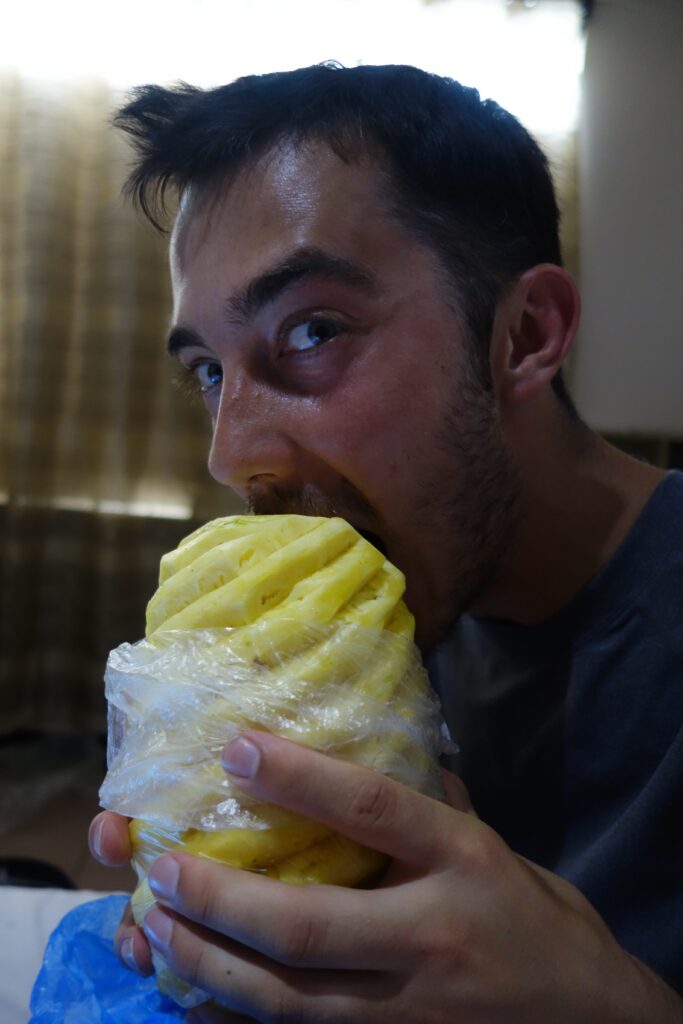
Coconut
Mature coconuts are great for cooking but wouldn’t but that much fun to eat directly. On the other hand, young coconuts are filled with water and have a thin, gelatinous fleshy layer on the inside. They are sold throughout the tropics. When purchased, the vendor will use a machete to remove the exocarp and part of the mesocarp (the green outer “shell” and fibrous layer underneath) and then cut a small hole on top. Stick a straw in and enjoy the fresh water with a mild coconut flavor. Once you’ve enjoyed the liquid, grab a spoon and eat the soft flesh. One vendor even cut us a spoon from the exocarp of the coconut!


One other interesting thing is that literally every coconut tree we saw in the Philippines had notches cut in the side to facilitate climbing. According to our guide in El Nido, the coconut palms growing on the beaches are not owned by anyone and you can climb up and cut down a coconut if you feel like it. I didn’t cut a coconut down, but I did climb up!
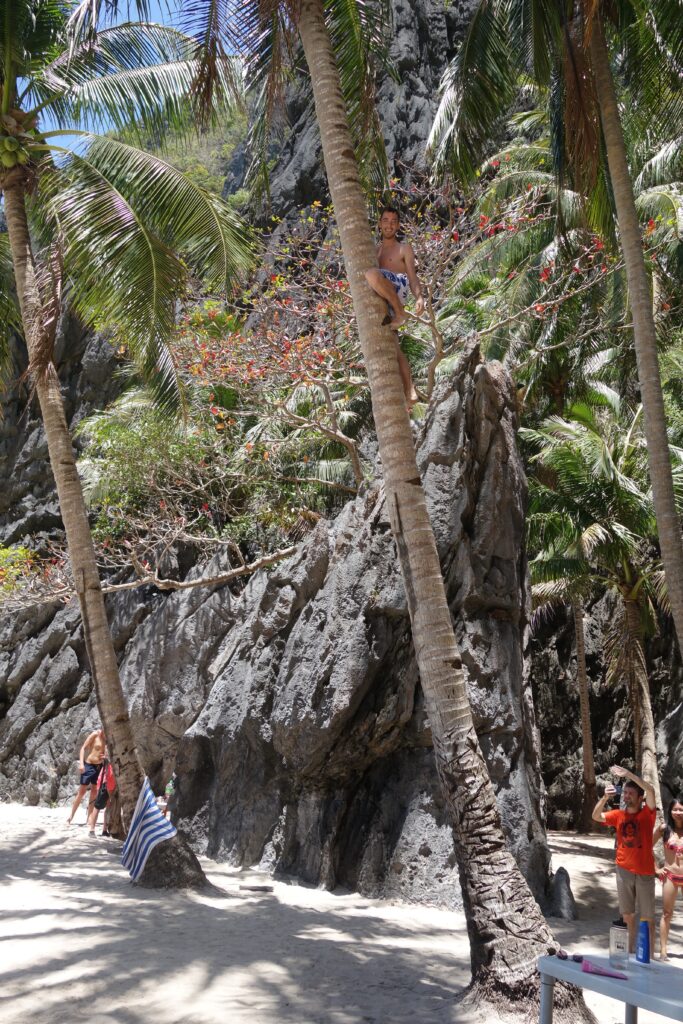
Dragon fruit
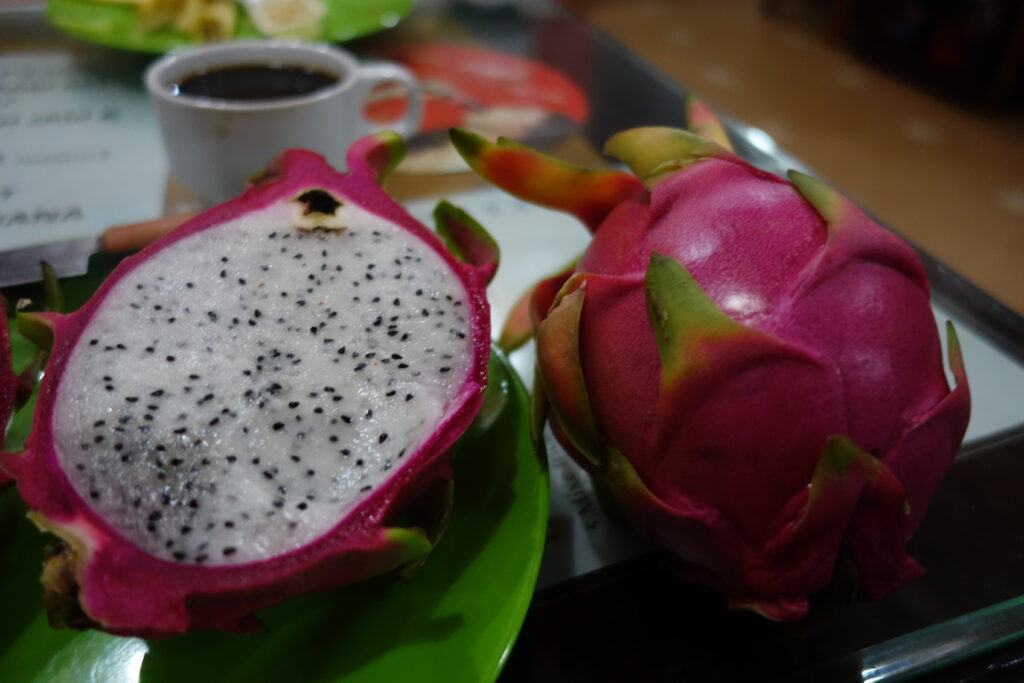
Now we are getting into slightly more unusual territory. The dragon fruit is actually a native of Mexico that is now grown widely in Vietnam. I was surprised to find that this fruit doesn’t grow on a tree, but on a type of cactus. It has a bright pink/red skin and a somewhat firm pale white flesh. The flesh has a pleasant but mild flavor with seeds that are crunchy if you go out of your way to chew them. I think it is the most beautiful fruit.
For fear of the imported fruit bringing pests, dragon fruit was not allowed for sale in the U.S. In the late 90’s the USDA started allowing the fruit to be imported, provided it is first irradiated. While we have tried it at home, it is unsurprisingly better when fresh and local. If you haven’t tried it before, its pleasant but mild flavor would be almost impossible to dislike. Look for it at the exotic fruit section of your grocer or at an Asian market.
Jackfruit

The jackfruit is the largest tree borne fruit in the world. The mature fruit can weight up to 80 pounds and we’ve seen some specimens at the market that must be approaching that weight. The fruit is bright yellow, has a firm texture and a flavor reminiscent of mango, banana, apple, and pineapple. We also notice a hint of bubblegum when eating it. It’s also delicious when dried. You’ll notice the fruits growing on trees everywhere you look in the Philippines and Vietnam.
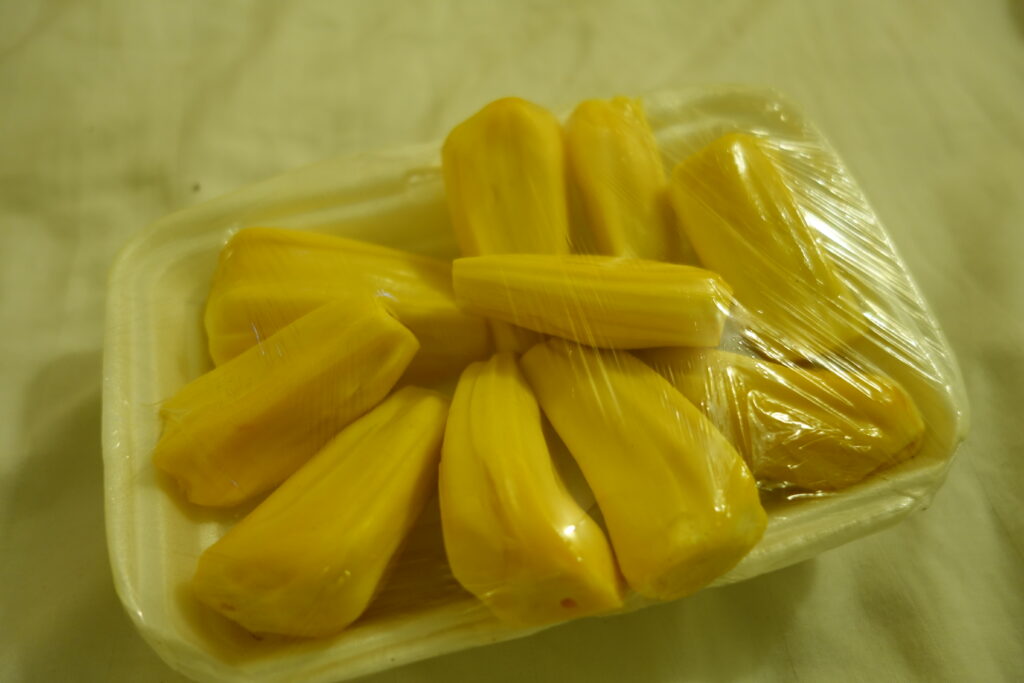
Longan

At first glance, the longan doesn’t look like a fruit, let alone like something edible. To me the fruits looks like the galls a tree forms to try to fight off invading pests. Don’t they look like these oak tree galls?
Yet when you start to peel the hard woody shell you will find a translucent white fleshed fruit inside.

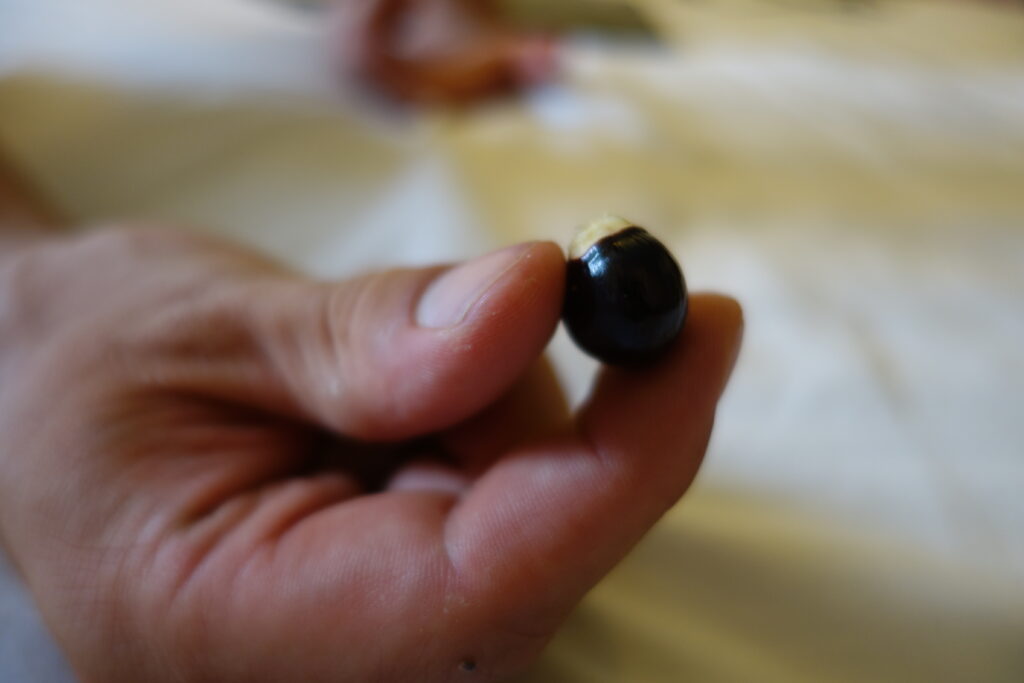
The flesh has a mild crunch and a flavor that reminds me of fresh concord grapes. I’ve read the flavor is similar to another Asian fruit, the lychee, though I haven’t yet had an opportunity to try one.
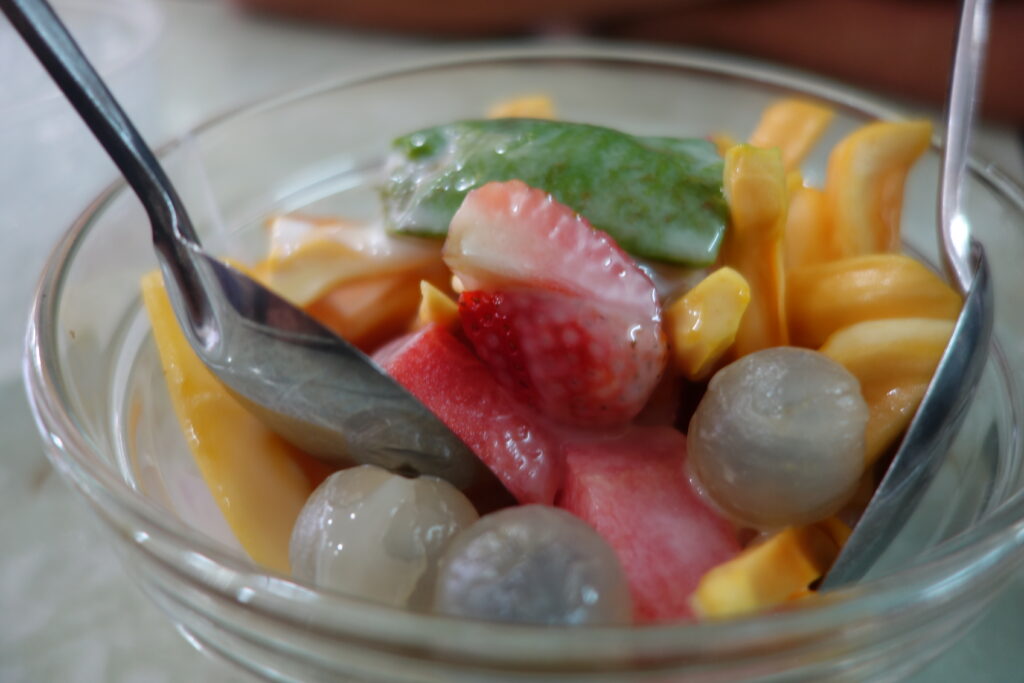
Rombutan
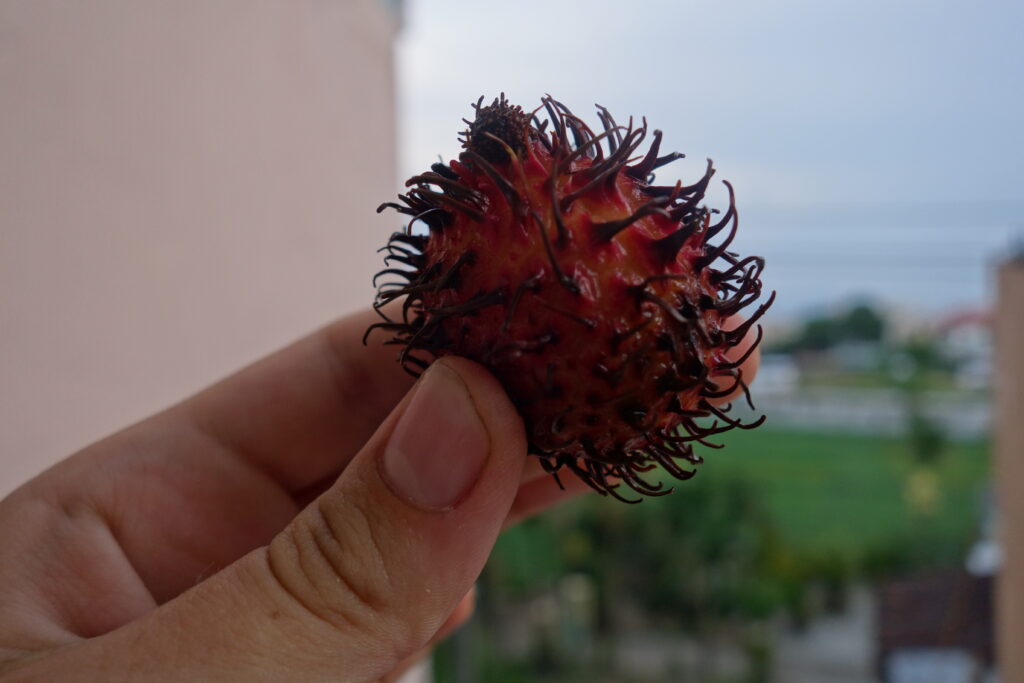
The rambutan is quite similar to the longan except that it looks much more exciting. We think the flavor is milder than the longan and resembles grapes in flavor and texture.

Soursop
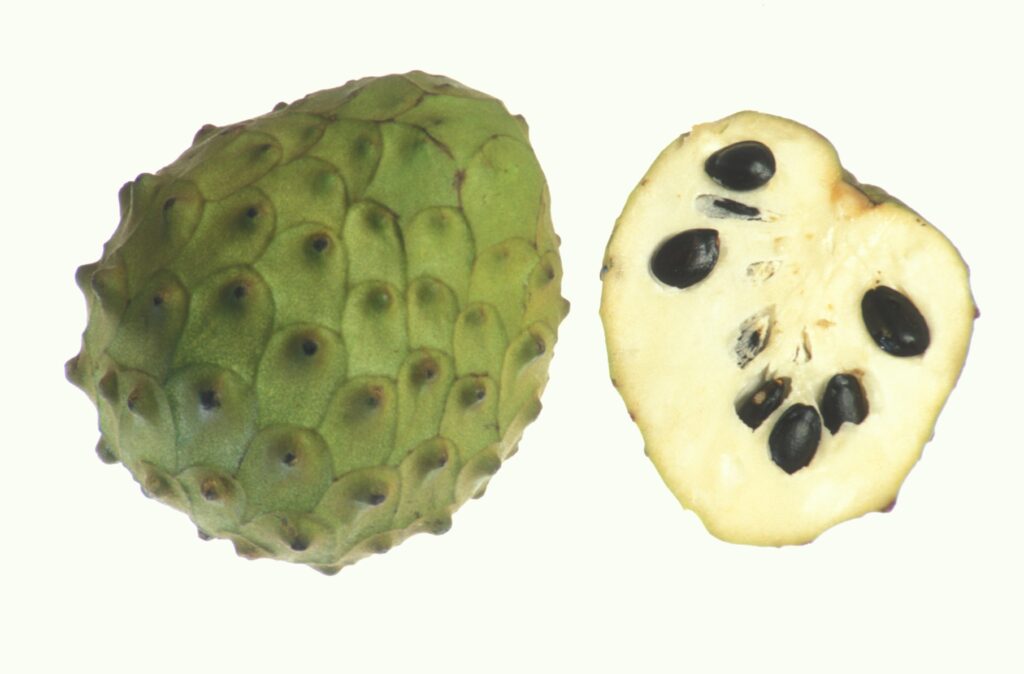
Also known as guyabano, this fruit is native to Central America and northern South America. We had soursop jam, soursop shakes on various beaches, and dehydrated soursop in the Philippines. The flavor is hard to describe, but it’s quite sweet with a nice sour citrus flavor as well. Its flavor also has some strawberry and coconut notes.
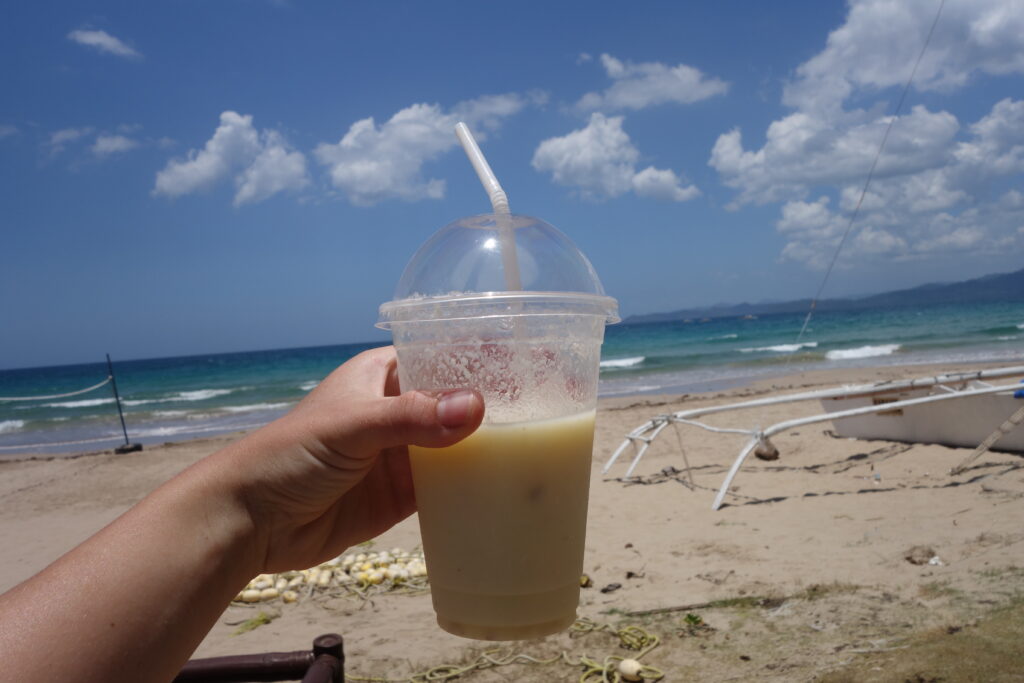
Sapodilla
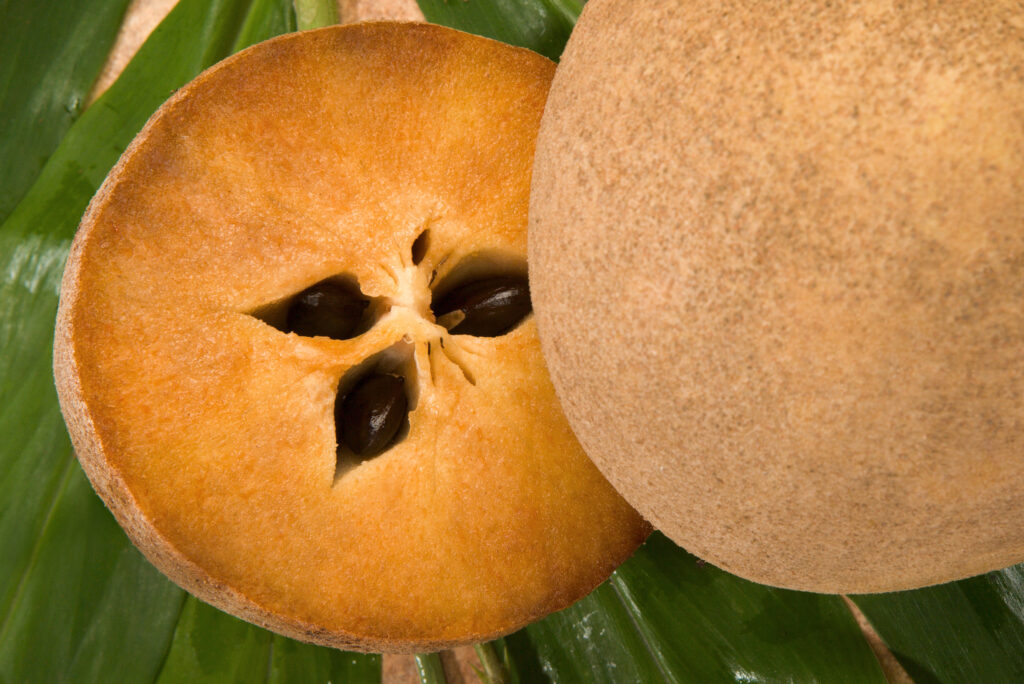
Native to southern Mexico, this is another fruit that is now found throughout the tropics. We first got to try this one in a shake but fortunately later we found some in the market. This was one of my favorites – it has a rum soaked, brown-sugar-sweetened pear flavor. I’ve never seen this fruit anywhere in the U.S. Now that we’ve had a few I can confidently say this is one of my all time favorite fruits. It’s flesh is soft and can be eaten with a spoon – wonderful.
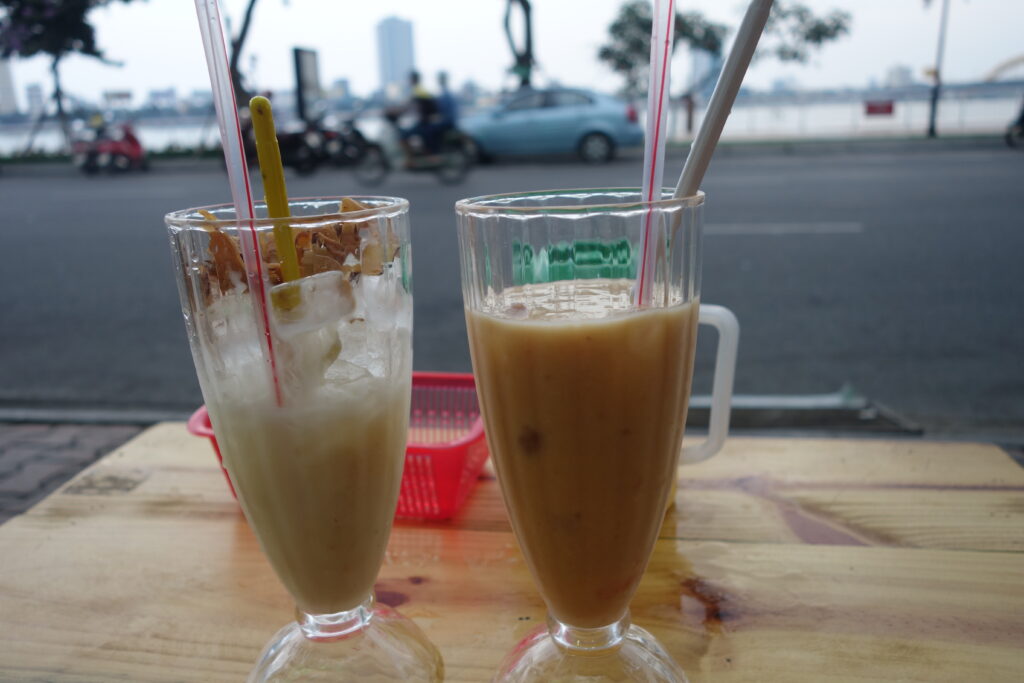
Custard Apple
This fruit is related to the soursop. We’re still waiting for a chance to try a fresh one and then we’ll update this post! We did get to have pieces of one in a smoothie, as seen above, and it was quite good. The texture is a bit chewy but what it lacks in texture it makes up for in flavor.
Mangosteen

The mangosteen is not a mango – nor is it remotely related to mangoes. It is a small bright purple fruit – once you crack open the shell you find soft white arils inside with an intense and pleasant taste. This is one of the most expensive fruits here and if you manage to find it at home it will probably be really expensive.
The fruit remind me a bit of the texture and flavor of the fruit of the cocoa bean (which we had a chance to try in Hawaii at a coffee plantation) but the flavor is also really bright and airy and reminded me a bit of pomegranate. The fruit also has vanilla and peach notes.
Durian
I saved the best for last. The durian stands alone among the fruits. Regarded by many in Southeast Asia as the “king of fruits”, the first thing to know about a durian is that it smells. When I say it smells, I mean, it reeks. You know when somebody has one nearby through smell alone – often from dozens of meters away. In fact its smell is so pungent that they are banned on public transportation in Singapore. The fruit looks quite strange as well. It is a large and spiky fruit that you wouldn’t want to land on you when it falls off the tree (if Newton were doing his famous reflections under a durian tree he would probably be dead).
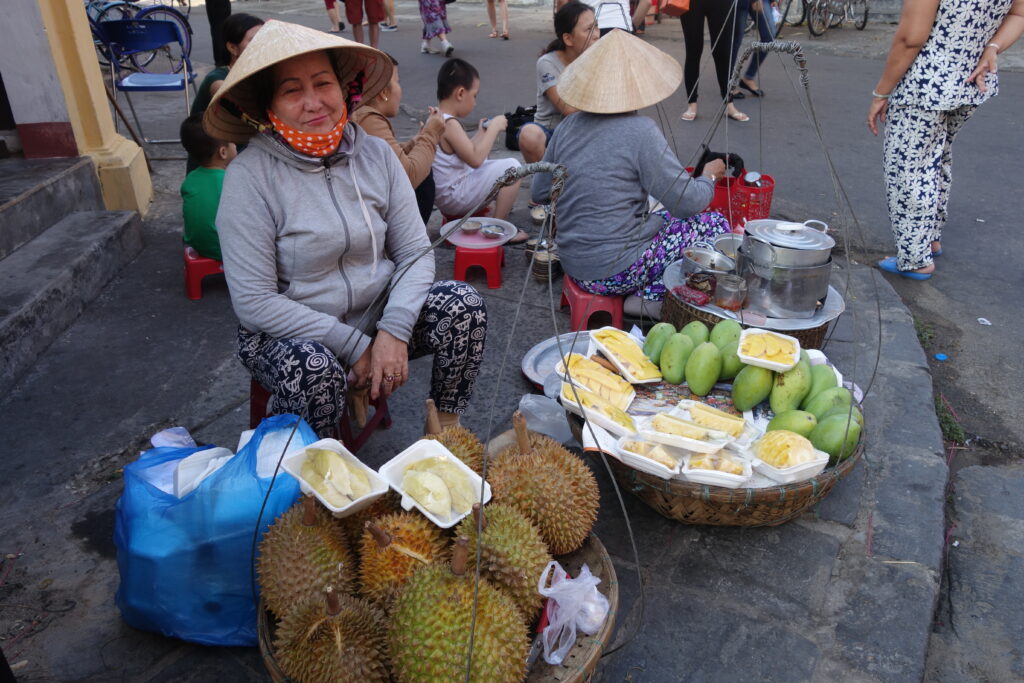
The durian is a very polarizing fruit. It seems one either loves it or finds it revolting. It is a food so unusual that Andrew Zimmerman of Man vs Food fame is unable to eat it. The texture of the fruit is like an egg custard – which gives you the feeling you are eating something rotten. The fact that it smells like something rotten contributes to the feeling as well. While a 19th century British naturalist Alfred Russel Wallace describes it as
A rich custard highly flavoured with almonds gives the best general idea of it, but there are occasional wafts of flavour that call to mind cream-cheese, onion-sauce, sherry-wine, and other incongruous dishes.
while food writer Richard Sterling says
… its odor is best described as pig-shit, turpentine and onions, garnished with a gym sock.
It is certainly a polarizing fruit. Personally I would describe the smell as sweet rotten onions with a sulfery note. The taste is much milder. While I still think it is a bit strange, I find myself liking it more and more each time I have it.
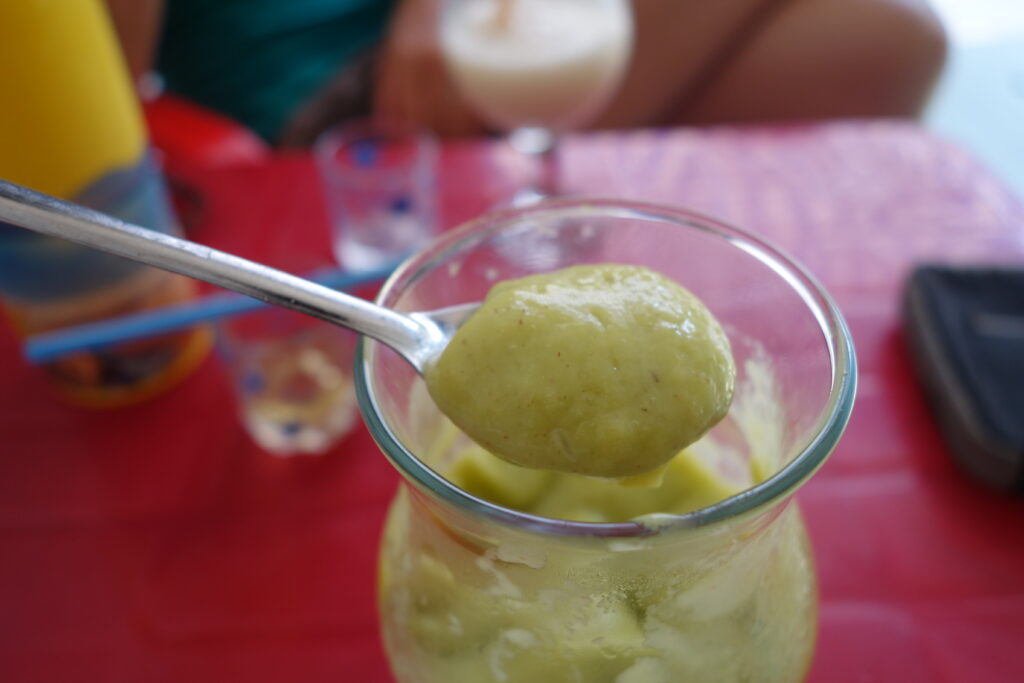
There is one thing nobody tells you about durians though – you’ll be revisiting the flavor for hours through durian flavored burps. I even had the durian burps the morning after eating one. We had tried a durian once before this trip – they are usually available at asian grocers – but the flavor of durian is strange enough to begin with that having it frozen, transported across the world and thawed really doesn’t help one get a fair taste of it.


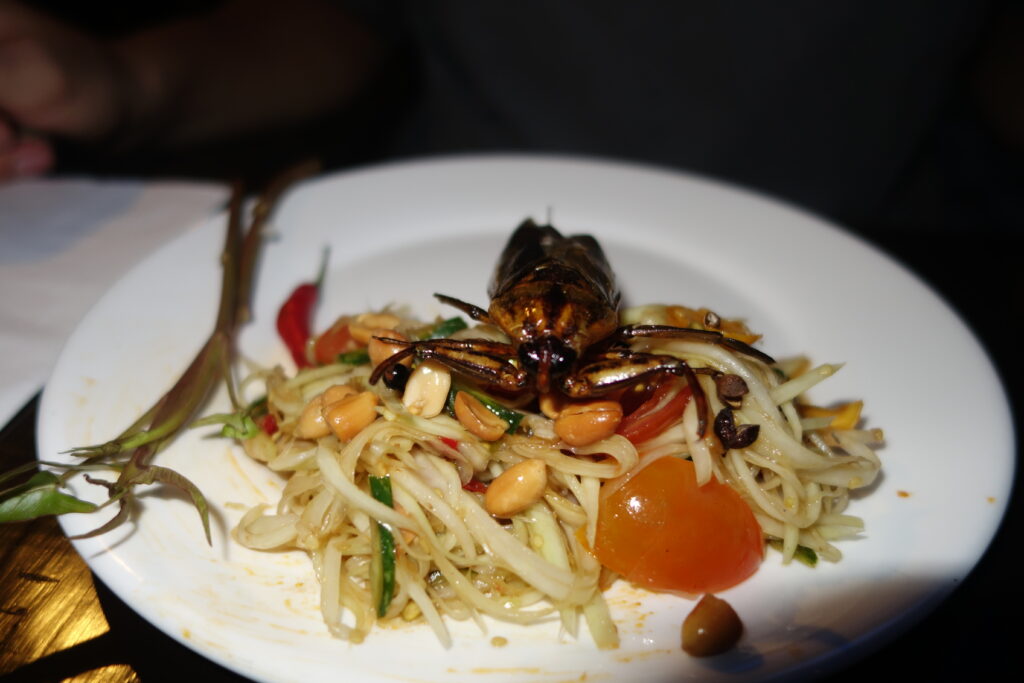

Wow… I wish there was a way you could include these fruits as attachments to your post. What an experience for the taste buds.
Fruits are one of the most enjoyable things traveling in Asia!!! I loved the mangos in China and almost can’t believe that they are even better in the Philippines… I also had quite a lot of those amazing mangosteens…
But what made me comment on this post… You haven’t tried lychees yet? Don’t you have them in the States? Here in Germany they are pretty common by now!
The mangosteens just keep getting better and better each time we have them! Yum.
I’ve seen lychee juice in the States, but never fresh lychees. I’m surprised to hear they are common in Germany! Are mangosteens available there as well?
Lychees started to get very popular about 10 years ago (I guess). Nowadays you find them in almost every supermarket (though I’m not quite sure if yearround – for some reason I associate them with Christmas time)
I have found mangosteens only once in Germany (in an asian supermarket in Hamburg) – but they didn’t have much taste
two posts in one week?! it’s a holiday!
-Coconut palm climbing photo: orange shirt dude seems to be shielding his precious eyes from the aerial view of Jon’s butt. hehe.
-DURIAN. have I told you about some of the string players at UW-Madison when I was there? a group of them would gather every so often in the lobby of the music school (basement floor of humanities…no circulation whatsoever), and chop open a durian and eat it together. humanities is huge. at least a football field’s length. you could smell that nonsense throughout the entire basement floor within minutes! The first time it happened, I reported that I smelled a gas leak because what else could that smell possibly have been? I was told others had already done the same. thankfully durian became banned from that building, and the idiot boys who instigated it just continued their idiocy outside 🙂
Haha! It really does look like he is shielding his eyes! He was actually taking a picture – one that is a lot cooler looking than the one I posted.
I almost wonder if the string players were eating it inside on purpose to mess with people. No one in their right mind would eat one indoors in a public place without realizing the smell would be bothering other people. When we had one in college my roommate Nick started gagging as soon as we cut it open!